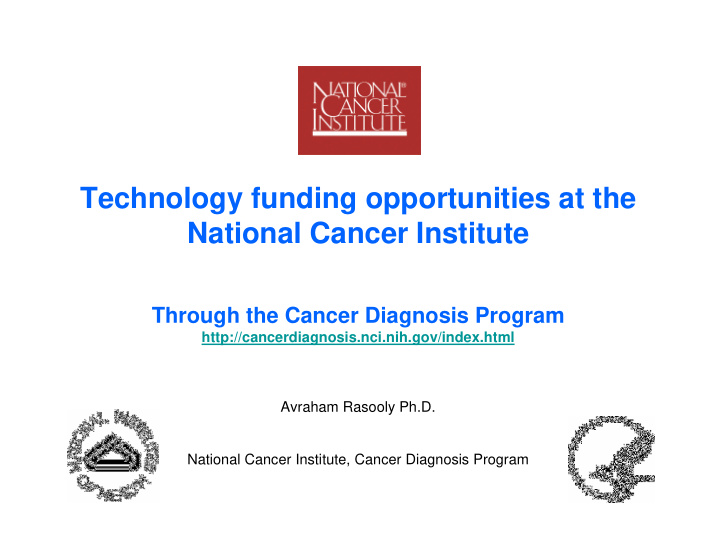



Technology funding opportunities at the National Cancer Institute Through the Cancer Diagnosis Program http://cancerdiagnosis.nci.nih.gov/index.html Avraham Rasooly Ph.D. National Cancer Institute, Cancer Diagnosis Program
The NCI Challenge Goal “ To eliminate the suffering and death due to cancer by 2015 ”
Cancer results from the gradual accumulation of multiple genetic changes in single cells Where We Want To Be Where We Are Detection Detection Malignant and and Tumors With Diagnosis Diagnosis Metastases Year 0 Year X Year Y Year Z Prevention Prevention/Modulation
Cancer: A Disease Process Lethal Phenotype Cancer Burden Evolution/ Progression Death Due to Malignant Cancer Transformation Susceptibility Pre-initiation Life Span Natural Birth Death
Hurdles for Early Detection of Cancer • Identification of risk populations • Lack of validated biomarkers • Technology limitations • Availability of annotated and quality assured tissues • Lack of new business model - engagement of the private sector • Regulatory science for early detection
NIH EXTRAMURAL FUNDING Investigator Reports PA/RFA Investigator- initiation Center for Scientific Programs Referral Review (CSR) Priority Outside payline Within payline Study Score Exception Section Appeal Advisory Board Grants Grants Not Administration Resubmission Funded Grants Funded Branch (GAB) $
NIH Main Funding Mechanisms RO1-Traditional Grants PO1-Program Projects R15-AREA Grants R21-Exploratory Grants R33-Exploratory Grants Phase II K-Training Grants R41-STTR R42-STTR Phase II R43-SBIR R44-SBIR Phase II
Eligibility for funding Universities Businesses Hospitals Medical centers Research institutions Government organizations Throughout the United States and abroad
Funding Cycles Three cycles a year Research Institutions:February, June, October Small business: April, August and December
Research areas of interest to the Diagnostic Biomarkers and Technology Branch. Technologies relevance to cancer diagnosis http://cancerdiagnosis.nci.nih.gov/about/index.html#tdb Devices: Micro-technology Nano-technology Microfluidics MEMS systems for molecular analysis Biosensors Automated sample preparation High-throughput systems Integration of technologies Other Research areas: Genomic Proteomic Bioinformatics
New NCI Request For Applications (RFA) for technology development: Innovative Technologies for Molecular Analysis of Cancer R21 or R33 (R43 or R44) (CA-05-002, CA-05-006) 6M for FY05 Application of Emerging Technologies for Cancer Research (CA-05-003, CA-05-007) R21/R33 (R43/R44) 6M for FY05 Cancer Sample Preparation Methodologies (CA-05-004, CA-05-008) R21/R33 (R43/R44) 2.25M for FY05
Cover Letter: A Valuable Tool Suggest study section(s) Indicate individual(s) or organization(s) that would be in conflict Discuss areas of expertise appropriate for the application ’ s review
Amended Applications Two amended applications allowed Generally half of the reviewers are new Request for change of reviewers must be supported Address ALL the reviewers concerns An opportunity to revise and improve your application
Small Business Funding Opportunities http://otir.nci.nih.gov/cgi-bin/editsbir.cgi
Extramural Programs Extramural Programs Reserved for Small Business for Small Business Reserved SBIR: Set-aside Program for Small Business to engage in Federal R&D with potential for commercialization. STTR: Set-aside Program to facilitate cooperative R&D between Small Business and U.S. Research Institutions- with potential for commercialization.
SMALL BUSINESS SMALL BUSINESS ELIGIBILITY ELIGIBILITY For- profit privately own U.S. business At least 51% U.S.- owned and independently operated Small Business located in the U.S. 500 employees or fewer
SBIR/STTR: 3-Phase Program PHASE I • Feasibility study ( no preliminary data needed ) $100K and 6 months (SBIR) or 12 months(STTR) PHASE II • Full R/R&D 2-Year Award and $750K (SBIR) or $500K (STTR) PHASE III • Commercialization Stage Without SBIR Support
NIH SBIR Review Criteria Significance Science Approach Innovation Investigators Preliminary work Environment Safeguards for animal and human subjects Appropriateness of the budget Additional criteria for specific PAs, RFAs
Common Problems with Applications Conceptional problem Inadequately defined test of feasibility Diffuse, superficial, or unfocused research plan – Lack of sufficient experimental detail Questionable reasoning in experimental approach – Uncritical approach – Failure to consider potential pitfalls and alternatives Lack of innovation Lack of preliminary results Unconvincing case for commercial potential or societal impact Lack of expertise/lack of appropriate collaborators Unfamiliar with relevant published work Unrealistically large amount of work proposed
NIH Research Funding http://grants.nih.gov/grants/oer.htm • NIH funding opportunities: http://grants1.nih.gov/grants/guide/index.html • NCI funding opportunities: http://www.nci.nih.gov/researchandfunding#fundi ngopportunities
Nanotechnology: Critical Endeavor in Cancer http://nano.cancer.gov/resource_video_journey_wmv-high.asp • Imaging agents for diagnostics that will allowing detection at earliest stages • Real-time assessments of therapeutic and surgical efficacy • Multifunctional, targeted devices for delivering therapeutic agents directly to cancer cells metastasis of cancer • Agents that can monitor predictive molecular changes for Cancer prevention • Novel methods to manage the symptoms of cancer that adversely impact quality of life • Research tools that will enable rapid identification of new targets for clinical development
Pioneering New Technologies in Biomedical Research http://nano.cancer.gov/nanotech_why_in_cancer.asp Nanotechnology Deliver drugs specifically to disease sites while sparing normal tissue Use imaging technologies to identify abnormalities - whole body and individual cells Develop implantable biosensing devices to: Screen for disease markers with great selectivity and specificity Monitor responses to therapy within cells Create biomaterials and engineer tissue –
NIH Roadmap http://nihroadmap.nih.gov/ • New Pathways to Discovery pathways Molecular libraries Molecular imaging Structural biology Bioinformatics/Computational biology Nano-medicine • Research Teams of the Future High risk research Interdisciplinary teams Public-private partnerships • Re-engineering the Clinical Research Enterprise
Bioengineering • BECON: The mission of the Consortium is to foster new basic understandings, collaborations, and transdisciplinary initiatives among the biological, medical, physical, engineering, and computational sciences. • http://www.becon.nih.gov/becon_funding.htm Exploratory/Developmental Bioengineering Research Grants • http://grants1.nih.gov/grants/guide/pa-files/PA-03- 058.html
Questions? Ask us Ask your program director
Recommend
More recommend